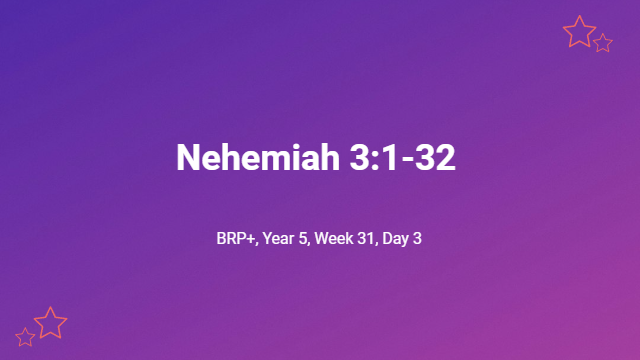Nehemiah 3:1-32
Q.1. What do we learn about the kinds of workers who got involved? Did everyone participate? Why were the first three gates important? – (Neh.3:1-12)
Nehemiah left us many lessons on how to lead, organize and manage a project. He was able to get all kinds of people working on the project, from the High Priest, to officials, goldsmiths, and perfumers. One of the officials of Jerusalem recruited his own daughters (Neh.3:12). The Tekoites had two working parties – … but their nobles did not support the work of their masters (Neh.3:5 c.f. 3:27). Were they lazy, or somehow contracted to Tobiah against the people (c.f. Neh.6:17-18)? The Sheep Gate (Neh.3:1 & 32) was where the sacrifices were brought to the temple. This explains why Nehemiah enlisted the high priest and his brother priest to work on this project. The Fish Gate (Neh.3:3) likely provided food for the city, and the Old Gate (Neh.3:6) was perhaps the original entry point into the city.
Q.2. Where were the next four gates located? What impact did Nehemiah’s organization have on the workers? – (Neh.3:13-27)
The next four gates were found in the lower lying areas that included the king’s garden (Neh.3:15), the artificial pool near the tomb of David, and the house of his mighty men (Neh.3:16 c.f. 2 Sam.23:8-39). These gates were – the Valley Gate (Neh.3:13), the Refuse Gate (Neh.3:14) where rubbish was taken out to keep the city clean, the Fountain Gate (Neh.3:15), and the Water Gate, (Neh.3:7) which provided both refreshment and water for the city. The commitment of such a range of people would have been inspirational. It was recorded – After him Baruch the son of Zabbai zealously repaired another section, from the Angle to the doorway of the house of Eliashib the high priest (Neh.3:20).
Q.3. Who were the repairers of the next three gates? What parts of the rebuilding were assigned to the groups? – (Neh.3:28-32)
Nehemiah was a smart director. He placed many groups in front of the places that they valued – 28 above the Horse Gate the priests carried out repairs, each in front of his house. 29 After them Zadok the son of Immer carried out repairs in front of his house. And after him Shemaiah the son of Shecaniah, the keeper of the East Gate, carried out repairs. 30 After him Hananiah the son of Shelemiah, and Hanun the sixth son of Zalaph, repaired another section. After him Meshullam the son of Berechiah carried out repairs in front of his own quarters (Neh.3:28-30). This section included the Horse Gate (Neh.3:28) that gave access to the stables, the East Gate (Neh.3:29 c.f. Ezk.44:2) that awaits the coming of Christ to set up His millennial kingdom, the Inspection or Mustering Gate (Neh.3:31), and the Sheep Gate (Neh.3:32 c.f. 3:1). Everyone was inspired to work tirelessly.

